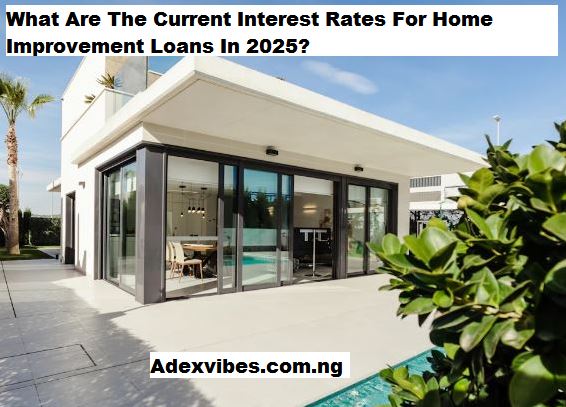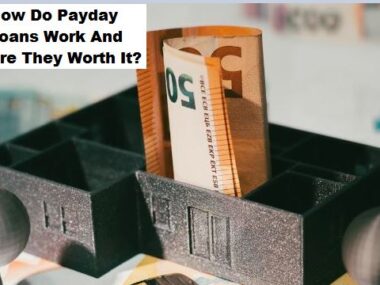Home improvement loans are a popular way for homeowners to fund renovations, whether it’s upgrading a kitchen, adding a new bathroom, or improving energy efficiency. With 2025 just around the corner, many people wonder, What are the current interest rates for home improvement loans in 2025? Understanding these rates is crucial, as the interest rate you receive can affect your monthly payment and the total cost of your renovation. Rates can vary based on a number of factors, including the type of loan, your credit score, and prevailing market conditions.
Interest rates for home improvement loans can fluctuate due to changes in the economy, and with 2025 on the horizon, many potential borrowers want to know where the rates are headed. The Federal Reserve plays a major role in setting the tone for interest rates, and their actions can have a significant impact on how much it costs to borrow money for renovations. In this guide, we’ll break down what are the current interest rates for home improvement loans in 2025 and look at the factors that influence these rates.
Understanding how to secure the best loan for your home project can save you a significant amount of money over time. Whether you are planning a major remodel or a smaller upgrade, knowing the rates and options available to you is key. Let’s dive into the specifics of home improvement loan rates and what you can expect in 2025.
Also, READ
What Are The Eligibility Requirements For An FHA Loan?
What Documents Are Required To Apply For A Personal Loan?
What Interest Rates Will Be In 2025?
In 2025, interest rates for home improvement loans are expected to be influenced by various factors, including inflation, economic growth, and the Federal Reserve’s monetary policy. While it’s difficult to predict the exact rate, analysts expect that interest rates will stabilize after recent increases in the previous years. The Federal Reserve has been raising rates to combat inflation, but as inflation pressures ease, rates are expected to moderate.
The Role of the Federal Reserve
The Federal Reserve is the primary driver of interest rates in the United States. In recent years, the Fed has raised rates to curb inflation, but by 2025, they may begin to lower them again as inflation cools. This could mean that interest rates for home improvement loans may decrease slightly in 2025. However, much will depend on the state of the economy. If inflation persists or the economy slows down, rates may stay higher for longer.
Fixed vs. Variable Rates
When considering what are the current interest rates for home improvement loans in 2025, it’s important to understand the difference between fixed and variable rates. Fixed rates stay the same throughout the loan term, while variable rates can fluctuate based on market conditions. In 2025, fixed rates may still be appealing for borrowers who want the certainty of a steady payment, but variable rates could be a good option if the economy stabilizes and interest rates drop.
Short-Term vs. Long-Term Loans
Interest rates also differ depending on the term length of the loan. Short-term loans, like personal loans for home improvement, often have lower interest rates than long-term loans. However, longer loans can be more affordable on a monthly basis, but they could end up costing more in interest over time. In 2025, we may see a wider variety of loan options available, as lenders adapt to the changing economic environment and offer competitive rates.
What Are Interest Rate Predictions For The Next 5 Years?
Interest rate predictions for the next five years are based on a variety of factors, including economic conditions, inflation rates, and the Federal Reserve’s policy decisions. While we can’t predict the future with certainty, experts have made several predictions that can give homeowners a general idea of what to expect when it comes to what are the current interest rates for home improvement loans in 2025.
Interest Rates and Economic Conditions
As we approach 2025, experts predict that interest rates will stabilize at lower levels than those seen in recent years. The U.S. economy has been recovering from the effects of the COVID-19 pandemic, and inflation has started to ease. If inflation continues to decrease, the Federal Reserve may begin to lower interest rates, making home improvement loans more affordable. By 2026 and beyond, rates could stabilize at historically low levels, creating more favorable conditions for borrowers.
Potential Risks and Economic Uncertainty
While the outlook for interest rates in the next five years is generally positive, economic uncertainty still poses risks. Changes in global markets, new economic crises, or changes in fiscal policy could cause rates to rise unexpectedly. Homeowners looking to take out home improvement loans in the coming years should be prepared for possible fluctuations in rates, although the general trend is expected to be downward.
Long-Term Loan Considerations
For those planning to take out loans over the next few years, it’s essential to consider long-term strategies. For example, locking in a fixed rate now could be advantageous if you expect rates to increase in the future. Conversely, if you anticipate lower rates in the next few years, waiting for the right time to borrow could help you secure a better deal.
What Is The Best Type Of Loan For Renovations?

When it comes to financing home improvements, there are several types of loans available, each with its own pros and cons. The best loan for your home renovation depends on factors such as the scale of your project, your credit score, and your overall financial situation. Here, we’ll explore some of the most common options for home improvement loans.
Personal Loans
A personal loan is one of the most popular options for home improvement. These loans are unsecured, meaning you don’t need to put your home or other assets up as collateral. The interest rates on personal loans can vary, but they tend to be higher than secured loans. However, they often offer fast processing times, which is ideal for homeowners looking to start their renovation projects quickly.
Home Equity Loans
Home equity loans allow you to borrow against the equity in your home. These loans tend to have lower interest rates than personal loans, making them an attractive option for larger home improvement projects. The downside is that you are using your home as collateral, so there’s a risk of foreclosure if you fail to make payments. Home equity loans typically have fixed rates, providing predictability in monthly payments.
HELOCs (Home Equity Lines of Credit)
A HELOC is similar to a home equity loan, but it works more like a credit card. You can borrow up to a certain limit, and you only pay interest on the amount you borrow. This makes HELOCs flexible, but they tend to have variable interest rates, which can change over time. HELOCs are ideal for homeowners who want to access funds for ongoing or smaller renovation projects.
What Is The Interest Rate On A Line Of Credit?
A home equity line of credit (HELOC) offers flexibility when financing home improvements, but the interest rates on HELOCs can vary. In 2025, the interest rate on a HELOC is expected to be influenced by the Federal Reserve’s monetary policy and market conditions.
Factors Affecting HELOC Rates
The interest rate on a HELOC is typically variable, meaning it can change based on economic factors. As of 2025, rates could fluctuate depending on inflation, Federal Reserve actions, and market competition. The rate on a HELOC is often tied to the prime rate, which can change as the Fed adjusts interest rates. Therefore, it’s important for homeowners to stay informed about the Federal Reserve’s actions if they are considering a HELOC.
Typical HELOC Interest Rates
In 2025, interest rates on HELOCs are expected to range from 6% to 9%, depending on your creditworthiness and the lender’s terms. If you have a higher credit score, you may qualify for a lower rate. Conversely, if your credit score is lower, you may face higher interest rates. While HELOCs are flexible and offer competitive rates, the risk of rate fluctuations means that you could see your monthly payment increase if rates rise.
Pros and Cons of HELOCs
The primary benefit of a HELOC is its flexibility. You can borrow and repay funds as needed, and you only pay interest on the money you use. However, because the interest rates are variable, there’s a degree of uncertainty involved. If you are considering a HELOC, make sure to understand how fluctuations in interest rates could affect your payments over time.
How High Will Interest Rates Be In 2026?
Looking ahead to 2026, experts predict that interest rates will stabilize after several years of fluctuation. While it’s impossible to know exactly what will happen, rates are expected to remain relatively low, barring any significant economic changes.
Rate Stabilization
By 2026, interest rates may stabilize as inflation decreases and economic growth continues. The Federal Reserve’s policies will likely play a significant role in determining whether rates stay low or rise again. For homeowners looking to take out loans for home improvements, this could create favorable conditions for borrowing.
Possible Rate Increases
However, there’s always the possibility that rates could increase if inflation or other economic factors require action from the Federal Reserve. If this happens, home improvement loans may become more expensive. Homeowners should keep an eye on economic trends and consider locking in rates now if they anticipate higher rates in the future.
How Many Interest Rate Cuts In 2025?
In 2025, there is a possibility that the Federal Reserve will make several interest rate cuts as the economy stabilizes. Many experts believe that the Fed will lower rates to encourage economic growth and combat any lingering effects of inflation.
Impact on Borrowers
If the Federal Reserve cuts interest rates, home improvement loan rates could drop as well. This would make financing home renovations more affordable for homeowners. It’s important to stay informed about Federal Reserve actions to take advantage of potential rate cuts.
What Are Current Interest Rates?
As of now, interest rates for home improvement loans in 2025 are higher than they were a few years ago, but they remain relatively stable. For personal loans, the interest rates are generally between 6% and 10%, depending on your credit score and lender. Home equity loans and HELOCs typically offer rates between 5% and 8%, though these can vary depending on your credit and the lender’s terms.
Conclusion
Understanding what are the current interest rates for home improvement loans in 2025 is key to making an informed decision about financing your home renovation projects. Interest rates can vary depending on the type of loan, the economic environment, and your creditworthiness. By considering your options carefully and staying informed about economic conditions, you can secure the best loan for your needs and enjoy the benefits of your improved home without breaking the bank.






